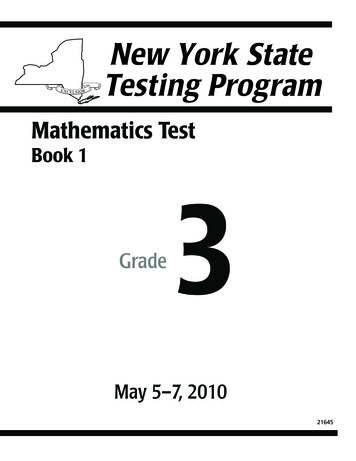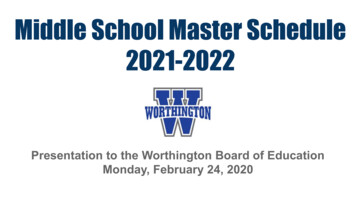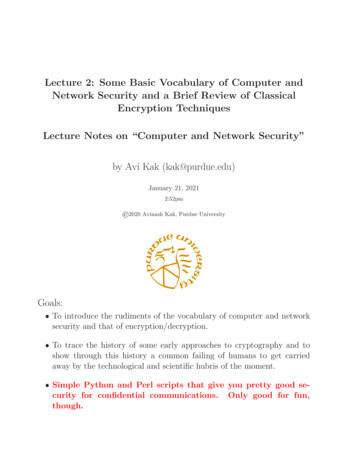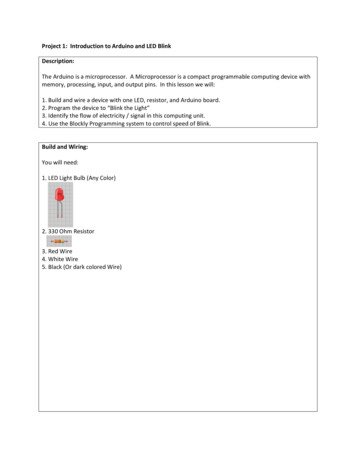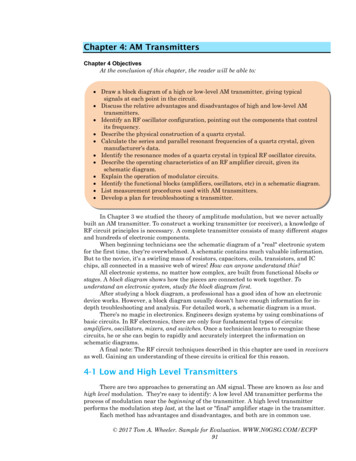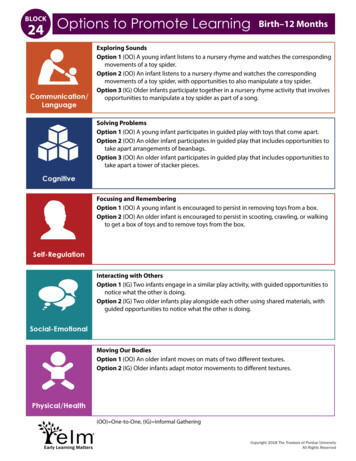
Transcription
24 Options to Promote LearningBLOCKCommunication/LanguageBirth–12 MonthsExploring SoundsOption 1 (OO) A young infant listens to a nursery rhyme and watches the correspondingmovements of a toy spider.Option 2 (OO) An infant listens to a nursery rhyme and watches the correspondingmovements of a toy spider, with opportunities to also manipulate a toy spider.Option 3 (IG) Older infants participate together in a nursery rhyme activity that involvesopportunities to manipulate a toy spider as part of a song.Solving ProblemsOption 1 (OO) A young infant participates in guided play with toys that come apart.Option 2 (OO) An older infant participates in guided play that includes opportunities totake apart arrangements of beanbags.Option 3 (OO) An older infant participates in guided play that includes opportunities totake apart a tower of stacker pieces.CognitiveFocusing and RememberingOption 1 (OO) A young infant is encouraged to persist in removing toys from a box.Option 2 (OO) An older infant is encouraged to persist in scooting, crawling, or walkingto get a box of toys and to remove toys from the box.Self-RegulationInteracting with OthersOption 1 (IG) Two infants engage in a similar play activity, with guided opportunities tonotice what the other is doing.Option 2 (IG) Two older infants play alongside each other using shared materials, withguided opportunities to notice what the other is doing.Social-EmotionalMoving Our BodiesOption 1 (OO) An older infant moves on mats of two different textures.Option 2 (IG) Older infants adapt motor movements to different textures.Physical/Health(OO) One-to-One, (IG) Informal GatheringCopyright 2018 The Trustees of Purdue UniversityAll Rights Reserved
BLOCK24Exploring SoundsBirth–12 MonthsOption 1One-to-OneSkill and GoalReceptive languageExpressive languageA young infant listensto a nursery rhyme andwatches the correspondingmovements of a toy spider.Be Prepared: Be familiar with the words, tune, and fingeractions of the “Itsy Bitsy Spider” nursery rhyme. Consider how touse a toy spider instead of your fingers for the geBEGIN: [Place the infant on his/her back in a supportedreclining position. Ensurethe infant can clearly seeyou.Hold the spider about 12inches from the infant.]ACT: This is a toy spider.[Pause for the infant to focus on the spider. Move the spider gentlyfrom side to side to attract the infant’s attention, if necessary.]Key ConceptsSongWatchListenMaterials NeededToy plush spiderOur toy spider is going to move when I sing a song. You can listento the song and watch the spider move. Are you ready for ourspider to move?[Make eye contact with the infant and sing “Itsy Bitsy Spider” slowly.Move the spider in ways that correspond with the words of the song.You may wish to use the following movements:yy tilt hand back and forth while moving spider upyy swoosh spider down and outyy tilt hand back and forth while moving spider up once againAlso PromotesCognitivePhysical/HealthPause after one round of the song and describe the infant’s reactions,including gestures and/or vocalizations. Example: “You are reachingfor our toy spider. Here, you can touch the spider! The spider is fuzzy.”Repeat the song with movements 1–2 times if the infant remainsengaged. After each round, talk about the infant’s reactions.]Optional ReadingSign and Sing Along: ItsyBitsy Spider by Annie KublerRECAP: [Describe what happened. Example: “I sang a song about a spider.You watched the spider go up and then swoosh down! You areholding the toy spider from our song! You are feeling the spider’sfuzzy body.”]Copyright 2018 The Trustees of Purdue UniversityAll Rights Reserved
BLOCK24Exploring Sounds (continued)Birth–12 MonthsOption 2One-to-OneSkill and GoalReceptive languageExpressive languageAn infant listens to anursery rhyme andwatches the correspondingmovements of a toy spider,with opportunities to alsomanipulate a toy spider.Key ConceptsSongListenWatchCommunication/LanguageBe Prepared: Be familiar with the words, tune, and finger actions of the “Itsy Bitsy Spider”nursery rhyme. Consider how to use a toy spider instead of your fingers for the actions.Invite an infant to sit on your lap fora song. Place the infant in your lapfacing to the side. Ensure the infantis secure in your arms and able tomake some eye contact. Introduce atoy spider. Encourage the infant tohold and explore the spider for a fewmoments. Then introduce the secondspider and explain that you are goingto sing a song about the spiders. Example: “I have a spider, too! I am going tosing a song about our spiders. You can listen to me sing the words. We canmove our spiders during the song! Are you ready?”Sing one round of the “Itsy Bitsy Spider” slowly, moving your spider in simpleways that correspond with the words. See movement suggestions in Option1. Describe the infant’s reactions, including gestures and/or vocalizations.Example: “You smiled and listened to our song. You watched my spider go upand then down. You waved your spider during our song!”Offer another round of the song and movements if the infant remainsengaged. Encourage the infant to move his/her spider as you sing.Materials Needed2 toy plush spidersConclude the session by recognizing the infant’s participation. Example: “Youhelped with our spider song! You cooed while I sang the words of our song.You watched my spider go up and then down. You moved your spider allaround!”Also PromotesCognitivePhysical/HealthOptional ReadingSign and Sing Along: ItsyBitsy Spider by Annie KublerCopyright 2018 The Trustees of Purdue UniversityAll Rights Reserved
BLOCK24Exploring Sounds (continued)Birth–12 MonthsOption 3Informal GatheringSkill and GoalReceptive languageExpressive languageOlder infants participatetogether in a nurseryrhyme activity thatinvolves opportunities tomanipulate a toy spider aspart of a song.Communication/LanguageBe Prepared: This activity is for infants who can sit independently. Be familiar with thewords and tune of the “Itsy Bitsy Spider” nursery rhyme. This activity option uses simpleup and down movements of the toy spider as part of the song.Invite 2–3 infants to join you fora song. Sit facing the infants andintroduce the toy spider. Explainthat our song is about a spider thatgoes up and down. With the spider inyour hand, facing the infants, slowlymove your arm up and then down.Emphasize the words up and down.Then sing one round of “Itsy BitsySpider” slowly while moving your spider up and down in correspondence tothe words. Describe and respond to gestures and/or vocalizations.SongUpDownGive each infant a spider. Provide a brief time for the infants to touch andmanipulate their toy spider. Then invite the infants to join you in movingtheir spider as you sing the rhyme. Emphasize up and down motions with thespider. After singing the rhyme with motions, describe the infants’ actions.Example (with a brief demonstration of each described action): “You raisedyour arms, James! Isabella rocked back and forth with our song! Jackson said‘up’!”Materials NeededRepeat the rhyme with actions if the infants remain interested. Conclude thesession with a brief description of how each infant participated.Key ConceptsToy plush spiders—1 perinfant and caregiverAlso PromotesCognitivePhysical/HealthOptional ReadingSign and Sing Along: ItsyBitsy Spider by Annie KublerWhat to Look For—Options 1–3Infants enjoy songs with finger or hand movements. Younger infants may coo,babble, or kick their legs. Older infants may join you in moving a toy spiderup and down with their hand or arm. It is not appropriate to explicitly teachthe up and down movements used in Option 3. Your informal demonstrationis sufficient. Some infants in each option may prefer to watch and listen only.All forms of participation are valuable and important to recognize. What isimportant in each activity option is exposure to words, music, and movement,with opportunities to participate if interested. Infants cannot be expected tohave a mental image or understanding of a spider, or the events and objectsconveyed in the rhyme. But the activity can informally support their awarenessof songs having a tune and words and sometimes actions that represent thewords.Copyright 2018 The Trustees of Purdue UniversityAll Rights Reserved
BLOCK24Exploring Sounds (continued)Communication/LanguageMore Scaffolding Tips—Options 1–3Extra support In Options 1 and 2, limit the number of movements with the toy spider if it appears theusual actions are too confusing for an infant to watch.Enrichment In Option 3, older infants who readily move their toy spider up and down might enjoydoing another action as part of the rhyme, such as using their fingers to pretend rain is coming down. Show and talk about pictures in the Optional Reading book with infants after the song and movementactivity.Interest AreaMaterials Needed: see belowEngage infants in familiar songs or rhymes during floor time. Offer rhymes and songs thatemphasize up and down hand or arm actions. “Hickory Dickory Dock” is a possible addition tothe “Itsy Bitsy Spider” offered in the activity options. Provide a rhyme-related toy for an infant tomanipulate, such as a toy mouse for “Hickory Dickory Dock.” Infants generally enjoy repeating songswith actions.Family Child CareMaterials Needed: Sign and Sing Along: Itsy Bitsy Spider by Annie KublerMany children are familiar with the “Itsy Bitsy Spider” rhyme and finger play. Read the book withchildren in your care. Demonstrate each sign and invite older children to imitate the sign. At theconclusion of the book, return to the beginning and invite children to join you singing and signingsome of the familiar words. Younger infants and toddlers will enjoy listening and watching. Infantsmay enjoy holding a plush toy spider during the activity.Copyright 2018 The Trustees of Purdue UniversityAll Rights Reserved
BLOCK24Solving ProblemsBirth–12 MonthsOption 1One-to-OneSkill and GoalProblem-solvingObject inquiry skillsA young infant participatesin guided play with toysthat come apart.Key ConceptsOnOffMaterials NeededStacking cupSmall ball (see Be Prepared)Also PromotesCommunication/LanguagePhysical/HealthBe Prepared: Secure a ball that is partially visible when placedinside the cup (see picture) and in a color that contrasts with thecolor of the cup.CognitiveDuring a tummy-time activity, place onestacking cup on the floor and invite theinfant to look at it. Then hold the ball for theinfant to see, and place it on the cup whenthe infant is looking. A portion of the ballshould be visible. Name each toy as you point.Describe what you are doing.Move the combined toys within reach of theinfant. Invite the infant to touch the toys. Helpthe infant touch the toys if he/she reachesfor them. Allow plenty of time for the infantto explore the toys. If the infant causes theball to fall off the cup, enthusiastically explainwhat happened. Example: “The ball was onthe cup. You touched the ball. The ball cameoff the cup!” If the infant does not touch thetoys, or his/her action does not cause theball to fall off the cup, tip the cup so the ball falls off. Explain what happened.Repeat the on and off actions as you describe each with short, clear phrases.Emphasize the words on and off. Pause after each so the infant has sufficienttime to look at each arrangement (ball off the cup, ball on the cup).Provide time and encouragement for the infant to play with the two toys ifinterested. Put the ball on the cup again so the infant has another opportunityto see the combined arrangement, and to maybe touch or manipulate thecombined toys.Describe the infant’s actions or what the infant is feeling with his/her fingers,hands, or mouth. Examples: “Ahh. Trina, you got the ball to your mouth.” “Umm.You feel the bumps with your tongue.” Repeat and expand on the infant’svocalizations.Copyright 2018 The Trustees of Purdue UniversityAll Rights Reserved
BLOCK24Solving Problems (continued)Birth–12 MonthsOption 2One-to-OneCognitiveBEGIN: [Invite an infant who can sit independently to play with thebeanbags. Sit on the floor near the infant. Name and point to severalbeanbags. Example: “This is a beanbag. This is a beanbag. This is abeanbag. We have a lot of beanbags!”Stack all of the beanbags, one on top of another. Describe what youare doing.]Skill and GoalProblem-solvingObject inquiry skillsAn older infant participatesin guided play thatincludes opportunities totake apart arrangements ofbeanbags.Key ConceptsApartPileLineMaterials Needed6 sensory beanbagsAlso nal ReadingFirst Words (Bright Baby) byRoger PriddyEXPLAIN: All our beanbags are in a pile. We have a pile of beanbags.[Point to the top of the pile.]ASK: Would you like to get a beanbag from our pile?ACT: [Pause for the infant to consider the pile. If the infant does not touchor start taking the pile apart, remove the top beanbag and thenreturn it to the pile or put it on the floor. Encourage the infant to takea beanbag off the pile.Describe the infant’s actions with simple, encouraging statements.Examples: “Xavier, you took a beanbag off our pile! Do you wantto get another beanbag?” “Wow, you are taking apart our pile ofbeanbags. You pushed them to the floor!”The sensory beanbags may prompt an infant to explore a beanbaghe/she removed. The infant may shake the beanbag, mouth it, or feelit with his/her fingers or hands. Support the infant’s exploration of abeanbag by describing his/her actions. Wait a few moments beforepointing to the stacked beanbags and encouraging the infant toremove one more beanbag.At this age, infants may use both hands to remove the beanbag.Some infants may dismantle the beanbag stack and set eachbeanbag on the floor. Continue to describe the actions in anencouraging manner.]EXPLAIN: Our beanbags were in a pile. Now our beanbags are all on thefloor! You took apart our pile of beanbags.[Emphasize the word apart. Point to the random arrangement ofbeanbags. Pause so the infant has time to look.]We can do something else with our beanbags. We can make a linewith our beanbags.Copyright 2018 The Trustees of Purdue UniversityAll Rights Reserved
BLOCK24Solving Problems (continued)CognitiveOption 2 continued[Place the beanbags in a line in front of the infant. Describe your actions as you arrange thebeanbags, from the infant’s left to right. Example: “First, the bumpy red beanbag. Next is thegreen beanbag. I am putting the gold nubby beanbag in our line, then blue, and then pink. Theshiny yellow beanbag is at the end of our line.” Emphasize the word line.]ACT: We can take apart our line of beanbags. Would you like to help me take beanbags awayfrom our line?[Encourage the infant to remove beanbags from the line. If the infant remains interested, he/she may be interested in your forming another pile or line of beanbags to take apart and/or inmanipulating individual beanbags.]RECAP: [Describe what happened. Example: “We had a pile of beanbags. You took the pile apart. Youtook each beanbag off the pile. Then our beanbags were on the floor. We made a line with ourbeanbags. Then we made another pile!”]Copyright 2018 The Trustees of Purdue UniversityAll Rights Reserved
BLOCK24Solving Problems (continued)Birth–12 MonthsOption 3One-to-OneSkill and GoalProblem-solvingObject inquiry skillsAn older infant participatesin guided play thatincludes opportunitiesto take apart a tower ofstacker pieces.Key ConceptsApartOffMaterials NeededKnob stacker toyAlso tiveInvite an infant who can sit independentlyto play with the knob stacker toy with you.Sit on the floor facing the infant and putthe stacking toy together as the infantwatches. Use simple phrases to explain youare putting the toy pieces together.Invite the infant to take apart the toy.Emphasize the word apart. In addition toyour words, use a gesture with the toppiece to communicate your invitation. If theinfant seems uncertain about what to do, remove 1–2 pieces, one at a time, asthe infant watches. Return each piece to the tower for the infant to remove.Describe the infant’s actions in taking each piece off the tower. Emphasize theword off. Example: “Tamara, you are taking the little blue piece off the tower.”Encourage the infant to remove each individual piece rather than knockingthe tower over.Draw attention to the pieces of the tower on the floor and explain that thepieces used to be in a tower. Emphasize that the infant took apart the towerby moving the toy pieces from the tower to the floor. The infant may beinterested in your creating another tower for him/her to take apart.What to Look For—Options 1–3The three activity options are designed to help an infant become aware ofhow objects can be changed by taking them apart. The options are gearedto different levels of cognitive and motor skills. In each activity, look foropportunities to emphasize changes in the arrangement of toys. Generally,before infants can put together toys, they are interested in taking them apart.The Option 1 activity may be brief and easily incorporated into a tummy time,as suggested. The ways in which the activity unfolds will depend partly on theinfant’s ability to hold up his/her head for a sustained time and use his/herarms and hands while on his/her tummy. The activity can be beneficial if theinfant watches only. Looking is a valuable way to explore.Option 2 offers a more pronounced change in the arrangement of toys(beanbags) and opportunities for the infant to create the change. Watch theinfant’s attention to the beanbags after they are removed from the pile (sittingrandomly on the floor). Make another pile of beanbags for the infant to takeapart if it seems the infant would prefer a repeat. Make a line of beanbags at alater point if time or infant interest is short.Copyright 2018 The Trustees of Purdue UniversityAll Rights Reserved
BLOCK24Solving Problems (continued)CognitiveIn Option 3, if an infant knocks over the tower, simply put it back together and demonstrate taking offone piece. Kindly say to the infant, “Let’s try it a different way.” Point to the top piece and emphasize theword off. Some infants may be interested in putting the tower together. Arrange the stacking pieces inorder by size. The largest stacking piece should be near the infant’s left hand, and the last piece of thetower should be on the infant’s right. Demonstrate how to set one on top of another, and give verbalguidance to the infant for stacking others.The activity plans continue the practice of a caregiver using simple phrases to describe objects andactions. Gestures and facial expressions are central to communications because infants will notunderstand most of the words you use. Still, your use of language (with pauses) can strengthen aninfant’s understanding that language is associated with objects and actions.The activities offer good opportunities to observe an infant’s fine motor skills, particularly coordinationof hands, fingers, and eye-hand. Examples of skills to observe: An infant may use two hands tomanipulate items. An infant may pick up a small item with a pincer grasp (thumb and index finger), a skillthat typically occurs between 8–12 months of age, or use a whole hand to grasp an item. You may see aninfant use a pincer grasp or his/her whole hand to grasp the nesting pieces. At this age, infants may useeither hand. A consistent preference for using one hand develops over the first two years.More Scaffolding Tips—Options 1–3Extra support In Option 1, align your actions with the cup and ball to when the infant is watching.You may wish to use words and slight movement of a toy to draw the infant’s attention, but it is notnecessary to coax the infant to be engaged. Offer this brief activity at a different time if the infant isinterested in something else. In Option 2, use beanbags without sensory differences if you anticipatethe sensory characteristics of beanbags will distract an infant from noticing how a pile of beanbags canbe changed. In Option 3, use 3–4 rather than the eight pieces of the stacking tower.Enrichment In Option 2, provide a clear container for the infant to put the beanbags into whentaking apart the pile. The infant may enjoy dumping the container of beanbags onto the floor. Drawattention to the way the beanbags scatter on the floor. In Option 3, point to and name the knob onseveral pieces. If an infant seems especially interested in details, show how the knobs help the pieces fittogether.Copyright 2018 The Trustees of Purdue UniversityAll Rights Reserved
BLOCK24Solving Problems (continued)CognitiveInterest AreaMaterials Needed: books, pictures of people and animals, cups, small and large toys, baskets orcontainers, animal figures, muffin cupsProvide books with single images on each page. Infants enjoy looking at photos of people andanimals.Make arrangements with cups and toys for non-mobile infants to view and touch. Create simple andattractive arrangements of play materials to support infants in learning by looking.Throughout the week, put items into baskets or containers for infants to remove. Example: Place amuffin pan where an infant can discover it. Put a soft animal figure or other small toy in each muffincup. Also, place items inside a cloth container for infants to remove.Provide materials for mobile infants to transfer from one container to another. Use both large andsmall play materials.Family Child CareMaterials Needed: toys in Options 2 and 3, The Three Bears by Byron Barton, story props—such asbowlsOlder toddlers and preschool-age children may enjoy putting together, independently or withyour help, the toys used in Options 2 and 3. Preschool-age children also may enjoy identifying theappropriate sizes of items, such as bowls, for the characters in The Three Bears as part of a booksharing.Copyright 2018 The Trustees of Purdue UniversityAll Rights Reserved
BLOCK24Focusing and RememberingBirth–12 MonthsOption 1One-to-OneSkill and GoalExecutive functionA young infant isencouraged to persist inremoving toys from a box.Be Prepared: This activity is for an infant who can reach for andgrasp small toys from a box. Place in a box five different smalltoys that will appeal to the infant. One possibility is Excellerations Sensory Surprise Box with 5 Shapes.SelfRegulationBEGIN: [Place next to you aninfant who can sitindependently or withsupport. Ensure theinfant can clearly seeyou. Smile and make eyecontact with the infant.]EXPLAIN: [Hold up the box of toys.]Key ConceptsLookReachFindThere are toys in ourbox. Look at this neat toy![Remove one toy from the box, show it to the infant, and return it tothe box.]You can reach into our box. You can find some fun toys in our box.Materials NeededBox with small toys (see BePrepared)Also PromotesCommunication/LanguagePhysical/HealthACT: [Encourage the infant to remove toys from the box.Communicate excitement when the infant removes a toy. Describethe infant’s actions and say the name of the toy. Example: “You founda ball! You reached into the box. You pulled a ball out of the box.”Recognize the infant’s reactions to toys removed from the box.Example: “You are smiling! You are having fun finding toys in thebox.”]RECAP: [Smile and make eye contact with the infant as you briefly describewhat happened. Example: “You reached inside the box. You workedhard to take toys out of the box. You had fun playing with the ball.”]Copyright 2018 The Trustees of Purdue UniversityAll Rights Reserved
BLOCK24Focusing and Remembering (continued)Birth–12 MonthsOption 2One-to-OneSkill and GoalExecutive functionAn older infant isencouraged to persistin scooting, crawling, orwalking to get a box oftoys and to remove toysfrom the box.SelfRegulationBe Prepared: This activity is for a mobile infant. Place in a box five different small toysthat will appeal to the infant. One possibility is Excellerations Sensory Surprise Box with 5Shapes.Sit or kneel several feet from amobile infant. Softly call the infant’sname and hold up the box of toys.Explain there are fun toys insidethe box. Remove one toy from thebox, say the name of the toy, andhold it steady for the infant to see.Return the toy to the box. Remindthe infant there are other toys in thebox.LookPullKeep the box on the floor near you and within full view of the infant. Invitethe infant to move toward you to get the box. Encourage the infant as he/shemoves toward the box. Examples: “You are coming to get our box of toys!” “Youare almost here!”Materials NeededWhen the infant reaches the box, invite him/her to take the toys out of thebox. Describe the infant’s actions and say the names of toys removed from thebox. Examples: “You are looking inside our box. You are smiling.” “You pulled ared ball from our box.”Key ConceptsBox with small toys (see BePrepared)Also siastically acknowledge the infant’s persistence in reaching the box andtaking toys from the box. Example: “You crawled to get the box of toys. Youlooked at all of the toys inside the box. You pulled out a ball and a ring to playwith.”What to Look For—Options 1–2Removing objects from containers is generally enjoyable to infants and is apart of other ELM activity plans. The current activity emphasizes persistence inremoving items (Options 1 and 2) and in getting the box (Option 2).Infants are likely to differ in how they approach the task of removing toys fromthe box. Some infants may prefer to remove only toys of interest. If this occurs,offer gentle encouragement to remove all toys from the box, but positivelyaccept an infant’s decision to leave some toys in the box. If an infant dumpsthe box of toys on the floor, encourage him/her to make a line or small groupof the toys by moving each with his/her hand or arm. Name each toy theinfant moves.See the Extra Support tips for ways to encourage the infant to remove toys,especially if there are distractions from the task. In some circumstances, youCopyright 2018 The Trustees of Purdue UniversityAll Rights Reserved
BLOCK24Focusing and Remembering (continued)SelfRegulationmay wish to become a partner with the infant in looking at and maybe removing some toys. Examples:“Let’s look in the box together. I see a ball! Do you want to reach in and get the ball?” “Look, I pulled thisball from our box. What would you like to pull from our box?”More Scaffolding Tips—Options 1–2Extra support If the infant seems initially reluctant to remove a toy from the box, pull one toy from thebox and give it to the infant. Encourage the infant to remove others. Place fewer toys in the box for theinfant to remove. Join the infant in looking inside the box together if you anticipate the infant is aboutto lose interest. Describe what you see in the box and encourage the infant to remove toys.Enrichment Invite the infant to place the toys back into the box.Interest AreaMaterials Needed: medium-sized, open cardboard box; assortment of familiar, small toysExtend the activity options by placing several familiar toys in a cardboard box. During floor time,invite one or several infants to look into the box. Encourage the infants to reach inside and pull outtoys of their choice. Describe the infants’ actions as they explore the toys. Some infants may enjoyputting the toys back in the box. Talk with infants about their discoveries.Family Child CareMaterials Needed: variety of toys in baskets, bins, or boxesInvite older infants and toddlers to practice dumping and filling containers with a variety of toys.Older children can dump toys to play with and then return toys to the container when they aredone. Describe children’s actions and encourage children to look at what their peers are doing.Copyright 2018 The Trustees of Purdue UniversityAll Rights Reserved
BLOCK24Interacting with OthersBirth–12 MonthsOption 1Informal GatheringSkill and GoalSocial interaction skillsTwo infants engage in asimilar play activity, withguided opportunities tonotice what the other isdoing.Key ConceptsPlayBedBe Prepared: The size of the each basket should accommodatea baby doll, so the basket can serve as a pretend bed. Place ablanket in the bottom of a basket.SocialEmotionalInvite two infants to play with the baby dolls. Give each infant a box with ablanket inside and a doll. Present the box with blanket and the doll separately,so the infant can put the doll in the basket if he/she wishes. Explain that thebaskets are pretend beds and it is time for the doll babies to go to sleep. Givetime for the infants to figure out what to do with the materials.If appropriate, offer prompts that may help infants pursue the bedtime theme.Example:“Jada, you are putting your baby in the basket. I think your baby is going tosleep! Would you like to cover your baby with the blanket?”Positively acknowledge an infant’s attention to the other infant. Example:“Jada, you are watching Samuel put his baby in the basket. I think Samuel’sbaby is going to sleep.” Conclude the play activity by briefly describing whateach infant did.Materials Needed2 similar or identical dolls2 baskets (see Be Prepared)2 small blanketsAlso ight 2018 The Trustees of Purdue UniversityAll Rights Reserved
BLOCK24Interacting with Others (continued)Birth–12 MonthsOption 2Informal GatheringSkill and GoalSocial interaction skillsTwo older infants playalongside each other usingshared materials, withguided opportunities tonotice what the other isdoing.Key ConceptsPlayPeopleMaterials Needed4–6 people figures3 boxes (shoe or tissue boxsize)Large fabric or felt piecesAlso lEmotionalBe Prepared: Arrange the play materials on the floor or on a low table. Create interest inthe materials by placing 1–2 figures inside a box, on top of a box, and/or in a box turnedon its side. Place the fabric/felt pie
words and tune of the "Itsy Bitsy Spider" nursery rhyme. This activity option uses simple up and down movements of the toy spider as part of the song. Invite 2-3 infants to join you for a song. Sit facing the infants and introduce the toy spider. Explain that our song is about a spider that goes up and down. With the spider in
